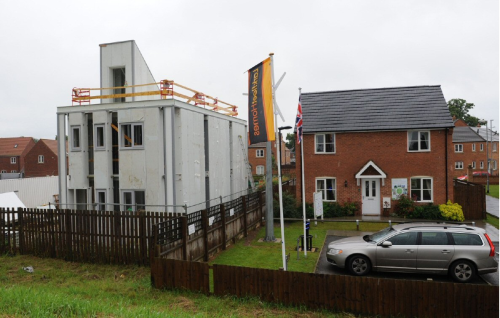
The Startlink House concept is a modular building in which all the parts are pre-fabricated and designed to fit together on site using minimal labour.
The major components used in the house are pultruded glass reinforced composite modules which can be rapidly assembled into a wide variety of low-rise buildings, without metal fastenings.
Larkfleet’s Startlink House weighs just 18 tonnes compared to a 40 tonne conventional house. Concrete foundations were not required.
Energy efficient, low cost housing
Startlink Lightweight Building Systems (SLBS) have been developed by a consortium of companies with funding from the UK government’s Technology Strategy Board.
| Building Research Establishment (BRE) data show that 46% of carbon emissions in the UK arise from buildings in use. An additional 6 -7% emanates from building construction. Startlink would significantly reduce carbon emissions from dwellings in both the construction and use phases. |
The consortium has created an energy-efficient, low cost housing method that is quick to build.
The SLBS processes and products, which Larkfleet helped to develop, provide the opportunity for housing to be constructed much faster, more energy-efficiently and at reduced costs in the future.
The Startlink partners are:
- Exel Composites UK (project lead), which produced the pultruded composite profiles;
- Odour Control Systems Ltd;
- Warwick University, which carried out materials testing and verification;
- Costain Group, a construction company which carried out the cost analysis; and
- J A Hutchinson BSc, conservation architect.
EDITOR'S COMMENT
The construction of lightweight, prefabricated, quick to install buildings is a logical application for composites, both for low cost permanent structures and emergency shelters. Here are three more examples.
- Innovative Composites International Inc (ICI) produces modular homes using composite sandwich panels constructed from glass fibre reinforced polypropylene skins and a honeycomb core. The company has housing projects under development in a number of countries. See: Innovative Composites to supply EcoScape modular housing to Brazil.
- Inovatec System produces insulating sandwich panels with structural skins of glass/epoxy and a foam core. A standard house can be constructed from prefabricated elements in 1-3 days. See Building on the advantages of composites in construction.
- SAFEHUT LLC manufactures collapsible, reusable composite shelters from FRP sandwich panels. The SAFEHUT system has a broad range of potential applications, including semi-permanent shelters for people displaced by natural disasters, construction site offices, and secure storage units. (See SAFEHUT composite shelter can be set up in 10 minutes.)




